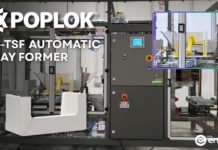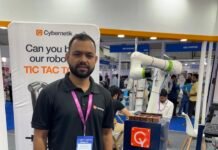Blurb –– From the global pandemic to the supply chain crisis – it’s been a turbulent few years for many industries, and consumer packaged goods (CPG) is no exception. To learn how CPG companies and their OEM suppliers are dealing with market uncertainty and changing consumer behavior, we sat down with B&R packaging specialist and Adaptive Ambassador, Wlady Martino.
What are the biggest challenges CPG companies are currently facing?
Wlady Martino – To understand what they’re dealing with, each of us can simply look at how our own behavior has changed in the past few years. We’ve spent less time in coffee shops and fitness studios and more time in our kitchens and living rooms. We have experimented with new brands, and many of us ordered our groceries online for the first time.
As we look ahead to a post-pandemic world, we can see that some of these changes are likely to last. We’ve gotten comfortable ordering a wider variety of products online. Employers have come to embrace the benefits of hybrid working. Our homes have become much more than just offices – they are now a hub for everything from learning and shopping to playing and exercising.
How are CPG companies responding?
Wlady Martino – To help people recreate the experience of offices, spas, gyms, and restaurants at home, CPG companies are rethinking their business models. Reaching consumers directly in their homes means putting the ‘last mile’ first and adopting direct-to-consumer (D2C) and omnichannel strategies.
Can you give us an example?
Wlady Martino – A few months ago, I was talking with a large US-based food and beverage customer. For them, the pandemic brought a sudden loss of demand for out-of-home experience products. But it also introduced a new demand for in-home alternatives. With coffee shops and bakeries closed, suddenly everyone’s a barista, looking to recreate the coffee shop experience at home in their own kitchen.
The customer’s new at-home line of products has been a great success, but the transition could have been a lot faster and more painless. The eCommerce trend had already been moving CPG companies toward more direct relationships with their customers. But, like so many others, this company wasn’t prepared for such a jolting overnight shift – with areas such as grocery eCommerce more than doubling in only two or three months.
What was it that they weren’t prepared for?
Wlady Martino – CPG producers have had to shift from large batches and wholesale packaging to small batches and individually packaged items, as well as boxes containing personalized mixes of items. Whether it’s in response to the pandemic or an effort to bring repackaging back in-house to improve margins, what it boils down to is that they require more frequent changes in production and packaging – from formats and materials to labeling and grouping.
And more frequent changes …
Wlady Martino – … mean smaller batches. If you’re running batches of 300,000 or 400,000 pieces, it’s no big deal to spend an hour cleaning and retooling the whole line every few shifts. But it’s a different story if you’re averaging 3,000 or 4,000 pieces – you end up with an hour of downtime for every hour of productivity. Consumers today are especially price-sensitive, and tight margins don’t allow for that kind of inefficiency.
What does that mean for machine builders?
Wlady Martino – While some global CPG companies have already started this transition, many more are looking for ways to catch the wave. Meeting their needs for increased flexibility while keeping overall equipment effectiveness high is a serious challenge they are passing on to their OEM suppliers.
How can B&R help them solve that challenge?
Wlady Martino – The B&R ecosystem offers a uniquely comprehensive scope of today’s most advanced automation technology – including machine vision, robotics, digital twin simulation, and mechatronic product transport. Our people have the knowledge and experience to combine these technologies in a way that gives manufacturing systems an unprecedented ability to adapt to all types of unexpected changes without sacrificing productivity. This is the crucial ability – known as adaptive manufacturing – that CPG manufacturers need to implement their new D2C and omnichannel strategies.
Does that mean building whole new lines?
Wlady Martino – Not always. That’s something we look at together with each customer – there has to be a business case to back up any project with a clear return on investment. In some cases, you can get the flexibility you need simply by finding one mechanical system that’s slowing down changeover and replacing it with a mechatronic solution. This is what one of our customers did with their pouch filler – they replaced a walking beam with a track system, and now their customers can change pouch formats on the fly.
And in other cases?
Wlady Martino – There is a threshold where you have really frequent changeovers, a higher level of personalization, and need to be ready for unforeseen future products. In those cases, a full-fledged adaptive manufacturing solution is the only answer. What we’re actually seeing more and more in the CPG industry are companies adding a dedicated line for eCommerce orders alongside their existing lines. That way, for a given product, they can use one line or the other depending on the required batch size. And they can leverage the full potential of what adaptive manufacturing has to offer.
Full-fledged adaptive manufacturing – what does that look like in practice?
Wlady Martino – In the personal care sector, some global producers have up to 30% of their sales going through eCommerce, so they have a really high level of maturity when it comes to leveraging adaptability. We have a customer in Poland who makes filling lines for high-viscosity products. With the enormous number of different bottle and cap combinations, frequent changeovers were becoming more and more of an issue.
So they rethought their entire approach – instead of three separate systems for filling, capping, and labeling, we designed the entire line around a continuous mechatronic backbone – ACOPOStrak. Instead of product holders, the bottles are clamped between two shuttles that can adapt their spacing on the fly.
As the backbone of an adaptive manufacturing solution, ACOPOStrak helps CPG companies handle frequent changes in product format, packaging materials, labeling, and grouping.
How do they benefit from that?
Wlady Martino – Eliminating changeover gave them a huge availability boost, and they had additional gains from eliminating deadtime for handover between equipment. There are no more infeeds and outfeeds, and they have continuous control over every product through processing stations that take advantage of machine vision and robotics.
Another huge benefit is that they can quickly and easily configure the machine for the needs of different customers and help them get new products to market fast. Their customers benefit from the ability to change over in minutes rather than hours – in some cases even at the push of a button. And, last but not least, there’s no need for specially qualified engineers or technicians. The line can easily be run by the same operator as a conventional filling line.
Thanks for your time!











